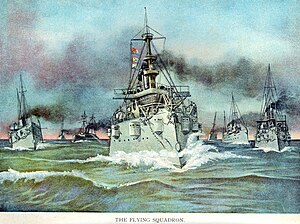Flying Squadron (US Navy)
| Flying Squadron | |
|---|---|

An illustration of the Flying Squadron, 1898.
|
|
| Active | 1898 |
| Country |
|
| Branch |
|
| Type | naval squadron |
The Flying Squadron was a United States Navy force that operated in the Atlantic Ocean, the Gulf of Mexico and the West Indies during the first half of the Spanish–American War. The squadron included many of America's most modern warships which engaged the Spanish in the Blockade of Cuba.
In the spring of 1898, tensions were rising between the United States and Spain over events in Cuba, particularly the explosion and sinking of the battleship USS Maine in Havana harbor. Although the U.S. Navy's leadership preferred to concentrate its fleet at Key West, Florida for operations against Cuba and Puerto Rico in the event of war, the American public and U.S. Government feared that a Spanish Navy squadron might cross the Atlantic from Spain and raid the East Coast of the United States.
The political pressure to establish a visible naval defense of the East Coast forced the Navy to reorganize itself to address the public's concerns. Accordingly, in April 1898, shortly before the outbreak of war, the Department of the Navy ordered the fleet to be divided.
The heavy units of the U.S. fleet formed the North Atlantic Squadron, commanded by Rear Admiral William T. Sampson, which was concentrating at Key West. The new organizational scheme imposed by the Department of the Navy transferred about half of that squadron's ships to a new Flying Squadron under the command of Commodore Winfield S. Schley, consisting of battleships Texas and Massachusetts, armored cruiser Brooklyn, protected cruisers Columbia and Minneapolis, and several auxiliary cruisers; Schley's flagship was Brooklyn. While the North Atlantic Squadron operated in the Caribbean and Gulf of Mexico in support of the efforts of smaller U.S. ships blockading Cuba and Puerto Rico, the Flying Squadron would be based at Hampton Roads, Virginia, poised to defend the Atlantic coast against Spanish naval attack.
...
Wikipedia
